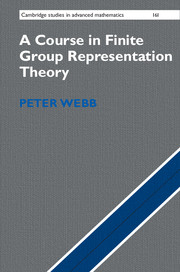Book contents
- Frontmatter
- Contents
- Preface
- 1 Representations, Maschke's Theorem, and Semisimplicity
- 2 The Structure of Algebras for Which Every Module Is Semisimple 15
- 3 Characters
- 4 The Construction of Modules and Characters
- 5 More on Induction and Restriction: Theorems of Mackey and Clifford
- 6 Representations of p-Groups in Characteristic p and the Radical
- 7 Projective Modules for Finite-Dimensional Algebras
- 8 Projective Modules for Group Algebras
- 9 Changing the Ground Ring: Splitting Fields and the Decomposition Map
- 10 Brauer Characters
- 11 Indecomposable Modules
- 12 Blocks
- Appendix A Discrete Valuation Rings
- Appendix B Character Tables
- Bibliography
- Index
2 - The Structure of Algebras for Which Every Module Is Semisimple 15
Published online by Cambridge University Press: 05 August 2016
- Frontmatter
- Contents
- Preface
- 1 Representations, Maschke's Theorem, and Semisimplicity
- 2 The Structure of Algebras for Which Every Module Is Semisimple 15
- 3 Characters
- 4 The Construction of Modules and Characters
- 5 More on Induction and Restriction: Theorems of Mackey and Clifford
- 6 Representations of p-Groups in Characteristic p and the Radical
- 7 Projective Modules for Finite-Dimensional Algebras
- 8 Projective Modules for Group Algebras
- 9 Changing the Ground Ring: Splitting Fields and the Decomposition Map
- 10 Brauer Characters
- 11 Indecomposable Modules
- 12 Blocks
- Appendix A Discrete Valuation Rings
- Appendix B Character Tables
- Bibliography
- Index
Summary
In this chapter, we present the Artin–Wedderburn structure theorem for semisimple algebras and its immediate consequences. This theorem is the ringtheoretic manifestation of the module theoretic hypothesis of semisimplicity that was introduced in Chapter 1, and it shows that the kind of algebras that can arise when all modules are semisimple is very restricted. The theorem applies to group algebras over a field in which the group order is invertible (as a consequence of Maschke's Theorem), but since the result holds in greater generality we will assume we are working with a finite-dimensional algebra A over a field k.
Schur's Lemma andWedderburn's Theorem
Possibly the most important single technique in representation theory is to consider endomorphism rings. It is the main technique of this chapter, and we will see it in use throughout this book. The first result is basic and will be used time and time again.
Theorem (Schur's Lemma).Let A be a ring with a 1 and let S1and S2be simple A-modules. Then HomA(S1, S2) = 0 unless S1 ≅S2, in which case the endomorphism ring EndA(S1) is a division ring. If A is a finite-dimensional algebra over an algebraically closed field k, then every A-module endomorphism of S1is multiplication by some scalar. Thus, EndA(S1) ≅ k in this case.
Proof. Suppose θ : S1 → S2 is a nonzero homomorphism. Then 0 ≠ θ (S1) ⊆ S2, so θ (S1) = S2 by simplicity of S2, and we see that θ is surjective. Thus, Ker θ ≠ S1, so Ker θ = 0 by simplicity of S1, and θ is injective. Therefore, θ is invertible, S1 ≅S2, and EndA(S1) is a division ring.
If A is a finite-dimensional k-algebra and k is algebraically closed then S1 is a finite-dimensional vector space. Let θ be an A-module endomorphism of S1 and let λ be an eigenvalue of θ. Now (θ − λI) : S1 → S1 is a singular endomorphism of A-modules, so θ − λI = 0 and θ = λI.
- Type
- Chapter
- Information
- A Course in Finite Group Representation Theory , pp. 15 - 23Publisher: Cambridge University PressPrint publication year: 2016



